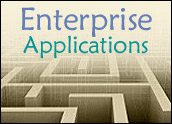
Organizations continue to innovate, develop and distribute applications in-house, taking a cautious approach to the adoption of Software as a Service (SaaS) and associated service-oriented architecture (SOA).
Application software decision makers, according to ones surveyed by Forrester Research, cited greater ease of integration (particularly with regard to real-time data integration), stronger tool sets for customization, a greater range of applications and tailored configuration capacity as reasons organizations prefer to rely on the on-premise and in-house development and deployment option.
They also reported loss of control and limited verticalization as reasons for shying away from SaaS.
However, organizations — large enterprises in particular — are starting to use a mix of proprietary and third-party SaaS on-demand application services, making use of the same Web services development tools and systems architectures as SaaS providers to develop and distribute their own on-demand applications.
In-House vs. SaaS
While there are typically greater up-front costs to developing and deploying applications in-house (especially when comparing license fees with subscription fees), annual costs remain lower for the on-premise option but increase during upgrade cycles. The latter represents around 65 percent of initial implementation costs in year eight of the 10-year horizon and Total Economic Impact (TEI) methodology used in Forrester’s research.
“TEI depends not only on number of users but also on number of sites. ROI (return on investment) methodologies, such as TEI, provide a framework for discussions that compare SaaS versus on-premise deployments,” principal analyst Ray Wang stated in a research report released last year.
“In general, as the number of users increases, on-premise models increase in financial attractiveness. However, enterprises operating in multiple geographies with 25 percent or more users in remote locations benefit more from SaaS options. Hence, when calculating the number of users, focus on centralized users versus remote users,” he said.
When evaluating alternative application development and deployment options, companies should consider hybrid models that allow for switching between on-premise and SaaS, according to Forrester Research. Decision makers should factor in and weigh the control and customization requirements addressed by an in-house solution against the scalability and adaptability offered by a good SaaS platform.
Mashing It Up
Greater ease of integration and customization are two of the main reasons organizations still prefer to go with in-house application development and deployment.
“Many organizations require highly customized solutions that exactly fit their unique needs — something they could not typically find out of the box in the traditional software industry. While I cannot speak to industry numbers, I can tell you that many internal IT organizations and third party developers are looking to the flexibility of the on-demand model to develop highly customized applications,” Kendall Collins, Salesforce.com’s senior vice president of marketing, told CRM Buyer.
SaaS vendors see the need of their biggest customers to streamline business processes by opening up their networks and extending applications to disparate user groups inside and outside the organization. Vendors such as Salesforce.com are now branching out, offering the means for their customers to leverage their on-demand platforms and application development tools to build proprietary application services.
Salesforce.com earlier this year released the Salesforce Platform Edition and Salesforce SOA, two innovative products that expand on the pioneering efforts the company has made in building up the SaaS market.
“Salesforce SOA provides the ability to mash up Salesforce.com’s multi-tenant on-demand service with enterprise workflow and business processes, enabling new kinds of enterprise applications on-demand.
“Traditionally, software-based SOA has required deploying and maintaining costly software and infrastructure, spurring lengthy, high-risk implementations that generate mixed results. Salesforce SOA enables SOA as a service, run on Salesforce.com’s on-demand platform, removing the cost and complexity associated with deploying and managing infrastructure,” Collins explained.
A Growing Number of Options
With the growing use of native Web services for business-to-business and intra-enterprise applications and Web 2.0 for business-to-consumer applications, groups of end users within economic and industry sectors are collaborating to develop their own shared on-demand SaaS platforms.
“There are cooperatives developing proprietary SaaS systems. For example, SWIFT (Society for Worldwide Interbank Financial Telecommunication) is a cooperative of global banks that is using SaaS development to support a long-standing strategy to facilitate financial transactions between banks in the European community. There are also vendors who support in-house SaaS development on top of their applications using SDKs (software development kits), but this brings in licensing revenue for the vendors and is not a competitive issue,” Eric Meerschaert, Sterling Commerce’s vice president of global marketing, told CRM Buyer.
“CIOs (chief information officers) want to reduce the number of software vendors they deal with. The resulting consolidation of the software industry has reduced the number of third-party software vendors, but not the volume of software being developed. That’s one of the reasons why CIOs seek best-of-breed options from industry veterans with strong financial backing, rather than maverick start-ups,” he added.
Organizations can now make use of a growing range of in-house, third-party, hosted or on-premise application development and distribution options. Sterling Commerce, for example, offers site licenses and managed services or outsourcing of those same solutions.
“We also provide a networked offering with our Sterling Collaboration Network, or VAN (value added network), that provides multi-enterprise integration through EDI (electronic data interchange) in a private, secure network environment via a hosted offering. We also offer network hosting and managed services over a hosted private network,” Meerschaert elaborated.
In the business-to-consumer segment, Sterling offers a range of multi-channel, native Web sales applications, including eStorefronts, eCatalog, Order Capture and Order Management while for multi-channel order fulfillment it has the Transportation Management Solution (TMS), Warehouse Management Solution (WMS) and Supply Chain Visibility (SCV) as Web services.
Room for Third-Parties In-House
Salesforce.com also recently announced the general availability of Apex Code in its summer 2007 release. According to Collins, Apex Code is a an on-demand, multi-tenant programming language that extends the capabilities of the Salesforce platform by introducing the ability to write code for on-demand applications that run on Salesforce.com servers.
The company also developed and supports the App Exchange Developer Network, or ADN, a community for those interested in developing on-demand applications.
“There, developers can find everything from blogs to wikis, and toolkits for Eclipse, Adobe Flex, Ajax (Asynchronous JavaScript and XML) and others which enable developers to create rich applications,” he added.
This story was originally published on Aug. 17, 2007, and is brought to you today as part of our Best of ECT News series.
Mixing It Up With SOA and SaaS, Part 2





















































